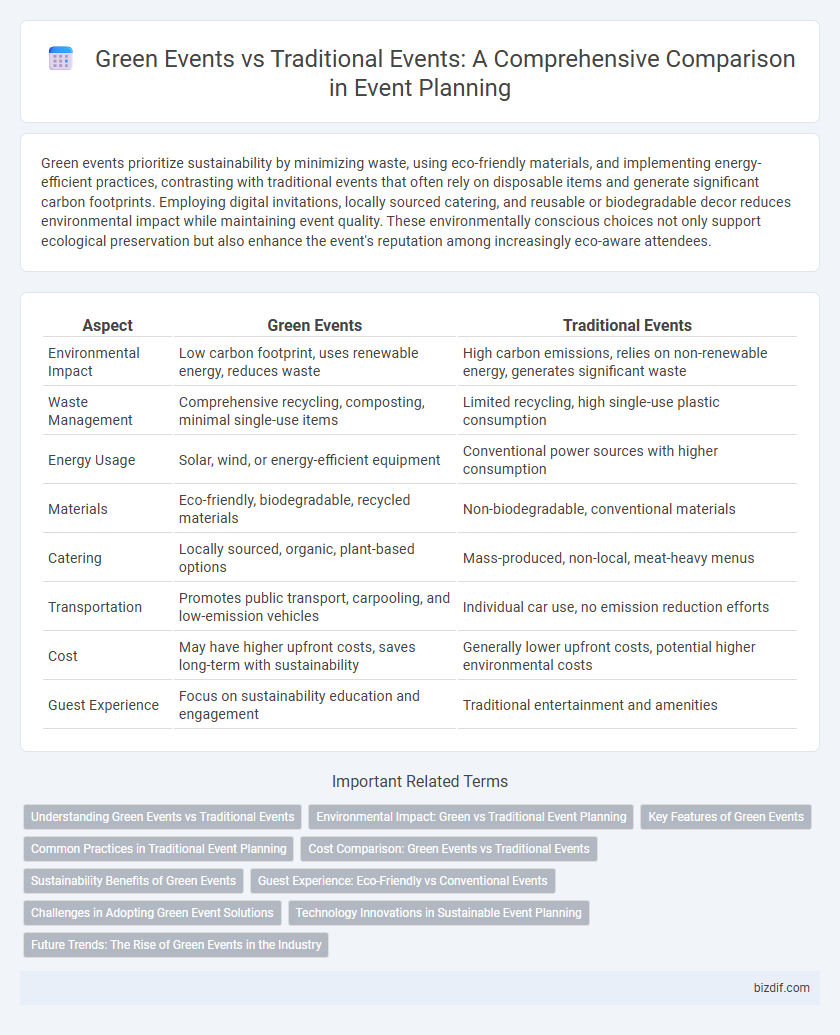Green events prioritize sustainability by minimizing waste, using eco-friendly materials, and implementing energy-efficient practices, contrasting with traditional events that often rely on disposable items and generate significant carbon footprints. Employing digital invitations, locally sourced catering, and reusable or biodegradable decor reduces environmental impact while maintaining event quality. These environmentally conscious choices not only support ecological preservation but also enhance the event's reputation among increasingly eco-aware attendees.
Table of Comparison
| Aspect | Green Events | Traditional Events |
|---|---|---|
| Environmental Impact | Low carbon footprint, uses renewable energy, reduces waste | High carbon emissions, relies on non-renewable energy, generates significant waste |
| Waste Management | Comprehensive recycling, composting, minimal single-use items | Limited recycling, high single-use plastic consumption |
| Energy Usage | Solar, wind, or energy-efficient equipment | Conventional power sources with higher consumption |
| Materials | Eco-friendly, biodegradable, recycled materials | Non-biodegradable, conventional materials |
| Catering | Locally sourced, organic, plant-based options | Mass-produced, non-local, meat-heavy menus |
| Transportation | Promotes public transport, carpooling, and low-emission vehicles | Individual car use, no emission reduction efforts |
| Cost | May have higher upfront costs, saves long-term with sustainability | Generally lower upfront costs, potential higher environmental costs |
| Guest Experience | Focus on sustainability education and engagement | Traditional entertainment and amenities |
Understanding Green Events vs Traditional Events
Green events prioritize sustainability by minimizing environmental impact through waste reduction, energy-efficient practices, and eco-friendly materials, contrasting with traditional events that often rely on disposable products and higher carbon footprints. Sustainable event planning integrates renewable resources, local sourcing, and digital alternatives to reduce overall emissions and resource consumption. Understanding these differences helps event planners align with environmental goals while maintaining effective event execution.
Environmental Impact: Green vs Traditional Event Planning
Green event planning significantly reduces environmental impact by prioritizing waste reduction, energy efficiency, and sustainable sourcing, contrasting with traditional events that often generate large amounts of non-recyclable waste and high carbon emissions. Utilizing renewable energy, digital ticketing, and local, organic catering further minimizes the ecological footprint of green events. In contrast, traditional events frequently rely on single-use plastics, excessive transportation, and high water consumption, contributing to greater environmental degradation.
Key Features of Green Events
Green events prioritize sustainability by minimizing waste through effective recycling and composting programs, using renewable energy sources, and reducing carbon footprints via eco-friendly transportation options. These events emphasize the use of biodegradable materials, locally sourced organic food, and digital marketing to decrease paper consumption. Water conservation, energy efficiency, and promoting environmental awareness among attendees are integral features distinguishing green events from traditional ones.
Common Practices in Traditional Event Planning
Traditional event planning commonly involves single-use materials such as paper invitations, plastic decorations, and disposable tableware, contributing to significant waste generation. Energy consumption is often higher due to reliance on non-recyclable lighting and sound equipment without sustainability considerations. Transportation arrangements typically overlook carbon footprint reductions, favoring convenience over eco-friendly options.
Cost Comparison: Green Events vs Traditional Events
Green events often involve initial investments in sustainable materials and eco-friendly technologies, which can be higher than traditional event costs. However, long-term savings emerge from reduced energy consumption, waste management expenses, and potential tax incentives. Traditional events may have lower upfront costs but incur higher environmental fees and waste disposal costs over time.
Sustainability Benefits of Green Events
Green events significantly reduce carbon footprints by utilizing renewable energy sources and minimizing waste through comprehensive recycling programs. Sustainable materials such as biodegradable decorations and reusable utensils lower environmental impact compared to single-use plastics common in traditional events. These practices not only conserve natural resources but also promote eco-friendly behaviors among attendees, aligning event planning with global sustainability goals.
Guest Experience: Eco-Friendly vs Conventional Events
Green events enhance guest experience by incorporating sustainable practices such as zero-waste policies, renewable energy sources, and locally sourced catering, creating an atmosphere that aligns with environmental values. Traditional events often prioritize convenience and elaborate setups, sometimes leading to higher waste generation and resource consumption, which may affect guest perceptions negatively in increasingly eco-conscious audiences. Eco-friendly events foster meaningful engagement by promoting awareness and responsible behavior, enriching the overall guest experience beyond standard expectations.
Challenges in Adopting Green Event Solutions
Adopting green event solutions presents challenges such as higher upfront costs for sustainable materials and technology, limited availability of eco-friendly vendors, and logistical complexities in waste management and energy efficiency. Event planners often face difficulties balancing environmental goals with attendee expectations and budget constraints. Overcoming these barriers requires strategic planning, stakeholder collaboration, and education on the long-term benefits of sustainable event practices.
Technology Innovations in Sustainable Event Planning
Technology innovations in sustainable event planning significantly reduce environmental impacts by integrating energy-efficient lighting, waste management systems, and digital ticketing solutions. Green events utilize smart technologies such as IoT sensors for real-time resource monitoring and AI-driven analytics to optimize logistics, minimizing carbon footprints compared to traditional events. These advancements promote eco-friendly practices by enhancing resource efficiency, reducing paper waste, and supporting renewable energy usage throughout the event lifecycle.
Future Trends: The Rise of Green Events in the Industry
The future of event planning is increasingly driven by sustainability, with green events reducing carbon footprints through eco-friendly materials, renewable energy sources, and zero-waste policies. Advances in technology enable virtual and hybrid event formats, minimizing travel-related emissions while enhancing attendee engagement. Industry reports project a significant rise in demand for green certifications and sustainable vendor partnerships, reflecting a broader commitment to environmental responsibility in the events sector.
Green events vs Traditional events Infographic

 bizdif.com
bizdif.com